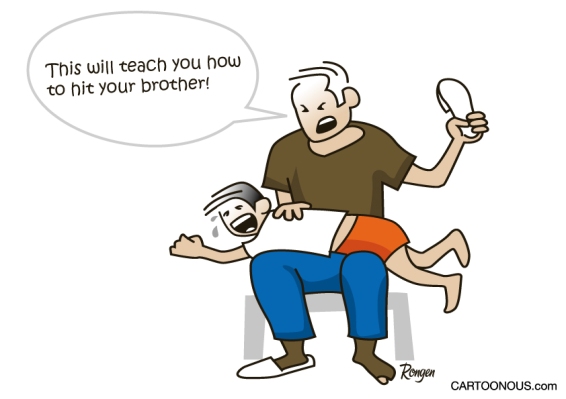Hi, There! Here’s the second part of our three-part series on Positive Discipline by expert Dr. Katharine C. Kersey of the Child Study Center at Old Dominion University.
Don’t forget to let us know what you think!
The Principles in Alphabetical Order
11. ABC Principle – Learn to think in terms of ABC (Antecedent, Behavior and Consequences). What was going on before the behavior occurred and what happened afterwards – as a result of the behavior? Many times you can find patterns in behavior – and alter your behavior or the circumstances that may have led up to the inappropriate behavior. Also, you might need to look at what is gained by the behavior – what the child is getting as a result. A child who is overly tired may throw a temper tantrum. In order to get him to stop, he may be given a toy. (In the future, he may throw a temper tantrum just to get a toy.) By changing the antecedent and/or the consequences, a temper tantrum may be avoided in the future.)
12. Allow Imperfection Principle – Don’t demand perfection. Remember no one likes the “perfect” child, parent or teacher. With perfection as the goal, we are all losers.
13. Anticipation Principle – Think ahead about whether or not the child is capable of handling the situation. If not, don’t take him (to expensive restaurants, church, beauty parlor, adult movies).14. Apology Principle – Apologize easily – when you goof, or “lose it.” (“I wish I could erase what I just said.” “You must have been scared by my reaction.” “I didn’t mean to hurt your feelings.” “I was wrong.” “I’m sorry.”) Apologize for your child (“I’m sorry he knocked you down”), but DON’T make your child apologize. (You might be making him lie OR think that wrong-doings can be rectified with an apology.)
15. Ask the Child Principle – Ask the child for input. “Do you think this was a good choice?” “What were you trying to accomplish or tell us with your behavior?” “What do you think could help you in the future to remember to make a better choice?” “How would you like for things to be different?” “How about drawing a picture of how you feel right now.” Children have wonderful insight into their own behavior and great suggestions for ways to make things better.
16. Availability Principle – Make sure that your child always knows where she can turn for help. If you aren’t available, be sure someone is. SET ASIDE 15 MINUTES A DAY to spend together. Let her plan how the time is spent.
17. Babysitter Principle – Get one.
18. Bake a Cake Principle – When all else fails, bake a cake together (and eat some after it cools). It is a great way to stay connected and build happy memories.
19. Best Friend Principle – Elicit help from the child’s best friend. Ask the best friend to see if he can encourage the child to “do the right thing.”
20. Bite Your Lip, Take Leave and Stay Home Principle – There is no place like home. Children might be picking up on our high level of stress. The best part of wisdom might be to scuttle our plans and go/stay HOME! Sometimes we need to take a reality check on our priorities.
21. Blame it on the Rules Principle – “Our school /family rule is to wash your hands before eating.”
22. Brainstorming Principle – Brainstorm with the child possible solutions to the dilemma, problem or predicament.
23. Bunny Planet Principle – (adapted from Rosemary Wells) – Close your eyes and tell the children that you are going to the bunny planet (or another imaginary place). Ask them to tell you when they are ready for you to come back (when things are quiet and they are ready to make good choices). If you are at home, you might go to the bathroom and wait for behavior to improve. Take your telephone, radio and books. Do not come out until behavior has changed.
24. Change of Environment Principle – If the child’s misbehavior cannot be stopped, move to another room or location. (Go outside.)
25. Chill Out Principle – It’s no big deal! Don’t make a mountain out of a molehill. This, too, will pass.
26. Class/Family Meeting Principle – Class and family meetings give children an opportunity to reflect, listen, empathize, and problem-solve. Focus on two-way communication rather than preaching to children. Listen more than you talk. Parents and children continue to learn from each other.
27. Collect Data Principle – Keep a written record of the frequency of inappropriate behaviors. Record the antecedents as well as the consequences. Look for patterns that may give clues as to possible reasons, situations and/or solutions.
28. Common Sense Principle – Use your common sense. Is this reasonable?
29. Cueing Principle – Give the child a cue such as a hand gesture to remind him – ahead of time – of the behavior you want him to exhibit. For example, teach the child that instead of interrupting when you are talking with somebody else, he is to squeeze your hand. This will let you know that he wants to talk to you (as you return the squeeze) and as soon as you can, you will stop the conversation and find out what he wants.
30. Divide and Conquer Principle – Separate children who are reinforcing each other’s misbehavior. Put adult between two children in a restaurant.31. Don’t Put the Cat with the Pigeons Principle – Don’t place temptation in front of the child. (Don’t leave the candy dish on the table if you don’t want the child to have any candy.)
32. Do the Unexpected Principle – React in a surprising way. Start doing jumping jacks! Clap a familiar rhythm (“Jingle Bells”) – to relieve the tension and get some perspective. It is amazing how, when your head is cleared, you can think better and decide on a more rational way to handle this situation.
33. Empowerment Principle – Develop child’s competency, skills, mastery, independence. Encourage him to solve his own problems. Let him know that his choices will determine his future.
34. Encouragement Principle – Give encouragement as often as possible. Help the child see the progress he has made. (“You got three spelling words correct. That is better than last week!” “Doesn’t it feel good to be able to zip your own zipper, make your own bed, clean up your own spills?”)
35. Establish Routines and Traditions Principle – Children behave better when they know what they can count on. Establish traditions which they can anticipate and which provide them with fond memories and feelings of belonging and security.
36. Extinction Principle – Ignore minor misbehavior that is not dangerous, destructive, embarrassing or an impediment to learning. (Look the other way. Play deaf.)
37. Follow Through/Consistency Principle – Don’t let the child manipulate you out of using your better judgment. Be firm (but kind)!
38. Frog Suit Principle – Teach the child to “put his/her frog suit on.” A frog suit protects the child from being hurt by other children’s careless or cruel comments.
39. Get on the Child’s Eye Level Principle – When talking with the child, get down on his/her eye level and look him in the eye while talking softly to him/her.
40. Get Support of Another Person Principle – Ask someone else to help you reinforce the positive behavior.
41. Give Life to an Inanimate Object Principle – Tell the child that “the toothbrush is calling,” or “the trash is calling that it wants to be taken out to the curb.” Give your voice a believable “squeaky” tone to make it more dramatic (and fun).
42. The Golden Rule Principle – Do unto your children what you would have them do unto you! Our children will (eventually) treat us the way we treat them. It pays to take a deep breath and think twice, so that we will tread gently.
43. Hand Gestures Principle – Develop hand gestures which signify, “Please,” “Thank you,” “More,” “Stop,” “Be Careful,” “Use your words,” and “No.”
44. Have Fun Together Principle – Children love to know that they bring us joy and pleasure. Lighten up and have fun.
45. Help Me Out Principle – Elicit the child’s support. Ask her/him to help you out.
46. Human Principle – Remember children have feelings too – just like we do. It is in everyone’s best interest to treat him or her as well or better than we treat other people for whom we are not responsible.
47. Humor Principle – Make a game out of it. Have fun. Laugh together a lot. (“How would a rabbit brush his teeth?”)
48. I Message Principle – Own your own feelings. “When you leave wet towels on the bed, the bed gets wet, and I feel angry. I would like for you to hang them on the hook behind the door.”
49. Institute Mailboxes Principle – Put mailboxes outside each child’s room, or attach one to each child’s desk. Write personal notes – suggestions, thanks, etc. and put inside the child’s mailbox. Be sure to have one on your desk or outside your room – for their messages back to you.
50. Jump Start a Belly Laugh Principle – Surprise your child by teaching him or her to jump start a belly laugh. Grab someone’s hands and jump up and down together, saying, “ho, ho” real fast, until you both are genuinely laughing. You’ll be surprised how good it feels to laugh. Your body and your brain both get a chance to “take a break,” and when you “come back” to where you were, you are both more relaxed and have better perspective.






